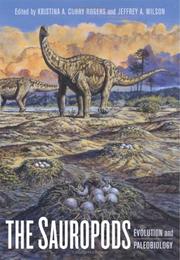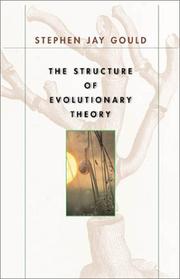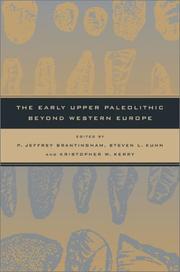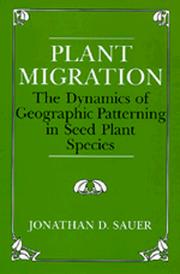| Listing 1 - 7 of 7 |
Sort by
|

ISBN: 1282358898 1423752678 9786612358890 0520932331 1598759388 9780520932333 9781423752677 9781598759389 9780520246232 0520246233 9781282358898 Year: 2005 Publisher: Berkeley : University of California Press,
Abstract | Keywords | Export | Availability | Bookmark
 Loading...
Loading...Choose an application
- Reference Manager
- EndNote
- RefWorks (Direct export to RefWorks)
Sauropod dinosaurs were the largest animals ever to walk the earth, and they represent a substantial portion of vertebrate biomass and biodiversity during the Mesozoic Era. The story of sauropod evolution is told in an extensive fossil record of skeletons and footprints that span the globe and 150 million years of earth history. This generously illustrated volume is the first comprehensive scientific summary of sauropod evolution and paleobiology. The contributors explore sauropod anatomy, detail its variations, and question the myth that life at large size led to evolutionary stagnation and eventual replacement by more "advanced" herbivorous dinosaurs. Chapters address topics such as the evolutionary history and diversity of sauropods; methods for creating three-dimensional reconstructions of their skeletons; questions of sauropod herbivory, tracks, gigantism, locomotion, reproduction, growth rates, and more. This book, together with the recent surge in sauropod discoveries around the world and taxonomic revisions of fragmentary genera, will shed new light on "nature's greatest extravagances."
Paleobiology. --- Saurischia --- Saurischia. --- Palaeobiology --- Biology --- Paleontology --- Saurischians --- Sauropoda --- Dinosaurs --- Anatomy. --- Morphology. --- Evolution. --- andesaurus. --- apatosaurus. --- brachiosaurus. --- camarasaurus. --- cetiosaurus. --- dicraeosaurus. --- dinosaurs. --- diplodocoids. --- diplodocus. --- early cretaceous. --- evolution. --- fossil digs. --- fossil record. --- fossils. --- gigantism. --- growth rates. --- herbivorous dinosaurs. --- malawisaurus. --- nemegtosaurus. --- nigersaurus. --- nonfiction. --- paleobiology. --- paleontology. --- prosauropods. --- reproduction. --- saltasaurus. --- saurischia. --- sauropod anatomy. --- sauropod herbivory. --- sauropods. --- science. --- shunosaurus. --- skeletons. --- titanosaur. --- titanosauriformes. --- tracks.

ISBN: 0674417933 0674417925 9780674417922 0674006135 9780674006133 9780674417939 Year: 2002 Publisher: Cambridge, Mass.
Abstract | Keywords | Export | Availability | Bookmark
 Loading...
Loading...Choose an application
- Reference Manager
- EndNote
- RefWorks (Direct export to RefWorks)
The world’s most revered and eloquent interpreter of evolutionary ideas offers here a work of explanatory force unprecedented in our time—a landmark publication, both for its historical sweep and for its scientific vision. With characteristic attention to detail, Stephen Jay Gould first describes the content and discusses the history and origins of the three core commitments of classical Darwinism: that natural selection works on organisms, not genes or species; that it is almost exclusively the mechanism of adaptive evolutionary change; and that these changes are incremental, not drastic. Next, he examines the three critiques that currently challenge this classic Darwinian edifice: that selection operates on multiple levels, from the gene to the group; that evolution proceeds by a variety of mechanisms, not just natural selection; and that causes operating at broader scales, including catastrophes, have figured prominently in the course of evolution. Then, in a stunning tour de force that will likely stimulate discussion and debate for decades, Gould proposes his own system for integrating these classical commitments and contemporary critiques into a new structure of evolutionary thought. In 2001 the Library of Congress named Stephen Jay Gould one of America’s eighty-three Living Legends—people who embody the “quintessentially American ideal of individual creativity, conviction, dedication, and exuberance.” Each of these qualities finds full expression in this peerless work, the likes of which the scientific world has not seen—and may not see again—for well over a century.
Evolution (Biology) --- Punctuated equilibrium (Evolution) --- Equilibrium, Punctuated (Evolution) --- Punctuated equilibria (Evolution) --- Punctuationalism (Evolution) --- Animal evolution --- Animals --- Biological evolution --- Darwinism --- Evolutionary biology --- Evolutionary science --- Origin of species --- Biology --- Evolution --- Biological fitness --- Homoplasy --- Natural selection --- Phylogeny --- adaptation. --- anagenesis. --- competition. --- divergence. --- fossil record. --- genetics. --- germinal. --- hierarchical selection. --- homology. --- inheritance. --- lamarckism. --- mass extinction. --- micro v macroevolution. --- modern synthesis. --- neo darwinism. --- origin of species. --- paleontology. --- punctuated equilibrium. --- speciation. --- variation.
Book

ISBN: 022639557X Year: 2018 Publisher: Chicago : University of Chicago Press,
Abstract | Keywords | Export | Availability | Bookmark
 Loading...
Loading...Choose an application
- Reference Manager
- EndNote
- RefWorks (Direct export to RefWorks)
Georges-Louis Leclerc, le comte de Buffon's The Epochs of Nature, originally published as Les Époques de la Nature in 1778, is one of the first great popular science books, a work of style and insight that was devoured by Catherine the Great of Russia and influenced Humboldt, Darwin, Lyell, Vernadsky, and many other renowned scientists. It is the first geological history of the world, stretching from the Earth's origins to its foreseen end, and though Buffon was limited by the scientific knowledge of his era-the substance of the Earth was not, as he asserts, dragged out of the sun by a giant comet, nor is the sun's heat generated by tidal forces-many of his deductions appear today as startling insights. And yet, The Epochs of Nature has never before been available in its entirety in English-until now. In seven epochs, Buffon reveals the main features of an evolving Earth, from its hard rock substrate to the sedimentary layers on top, from the minerals and fossils found within these layers to volcanoes, earthquakes, and rises and falls in sea level-and he even touches on age-old mysteries like why the sun shines. In one of many moments of striking scientific prescience, Buffon details evidence for species extinction a generation before Cuvier's more famous assertion of the phenomenon. His seventh and final epoch does nothing less than offer the first geological glimpse of the idea that humans are altering the very foundations of the Earth-an idea of remarkable resonance as we debate the designation of another epoch: the Anthropocene. Also featuring Buffon's extensive "Notes Justificatives," in which he offers further evidence to support his assertions (and discusses vanished monstrous North American beasts-what we know as mastodons-as well as the potential existence of human giants), plus an enlightening introduction by editor and translator Jan Zalasiewicz and historians of science Sverker Sörlin, Libby Robin, and Jacques Grinevald, this extraordinary new translation revives Buffon's quite literally groundbreaking work for a new age.
Natural history. --- popular science, vernadsky, lyell, darwin, humboldt, geology, translated works, translation, evolution, minerals, fossils, volcano, earthquakes, sea level, rock layers, fossil record, anthropocene, species extinction, mastodons, ice age, nonfiction, paleontology, genesis, allegory, religion, creation, cosmology, universe, enlightenment, earth sciences, history, france.

ISBN: 1597347159 0520928709 1282759124 9786612759123 9780520928701 0585466483 9780585466484 9780520233904 0520233905 9780520233911 0520233913 9781597347150 9781282759121 6612759127 0520233905 0520233913 Year: 2002 Publisher: Berkeley : University of California Press,
Abstract | Keywords | Export | Availability | Bookmark
 Loading...
Loading...Choose an application
- Reference Manager
- EndNote
- RefWorks (Direct export to RefWorks)
Always a controversial and compelling topic, the origin of life on Earth was considered taboo as an area of inquiry for science as recently as the 1950's. Since then, however, scientists working in this area have made remarkable progress, and an overall picture of how life emerged is coming more clearly into focus. We now know, for example, that the story of life's origin begins not on Earth, but in the interiors of distant stars. This book brings a summary of current research and ideas on life's origin to a wide audience. The contributors, all of whom received the Oparin/Urey Gold Medal of the International Society for the Study of the Origin of Life, are luminaries in the fields of chemistry, paleobiology, and astrobiology, and in these chapters they discuss their life's work: understanding the what, when, and how of the early evolution of life on Earth. Presented in nontechnical language and including a useful glossary of scientific terms, Life's Origin gives a state-of-the-art encapsulation of the fascinating work now being done by scientists as they begin to characterize life as a natural outcome of the evolution of cosmic matter.
Life --- Abiogenesis --- Biogenesis --- Germ theory --- Heterogenesis --- Life, Origin of --- Life (Biology) --- Origin of life --- Plasmogeny --- Plasmogony --- Evolution (Biology) --- Exobiology --- Spontaneous generation --- Origin. --- Origin --- amino acids. --- ancient world. --- big bang. --- biological evolution. --- biological. --- biology. --- biotic. --- comets. --- dna. --- evolution. --- extraterrestrial. --- fossil record. --- history of life. --- human biology. --- human evolution. --- hypotheses. --- living organism. --- meteorite. --- origin of life. --- prebiotic. --- research. --- rna. --- science. --- scientific history. --- scientific. --- solar system. --- supernova. --- tree of life. --- world history.
Book
ISBN: 0520959418 9780520959415 9780520277069 0520277066 Year: 2014 Publisher: Oakland, California : University of California Press,
Abstract | Keywords | Export | Availability | Bookmark
 Loading...
Loading...Choose an application
- Reference Manager
- EndNote
- RefWorks (Direct export to RefWorks)
Hans Thewissen, a leading researcher in the field of whale paleontology and anatomy, gives a sweeping first-person account of the discoveries that brought to light the early fossil record of whales. As evidenced in the record, whales evolved from herbivorous forest-dwelling ancestors that resembled tiny deer to carnivorous monsters stalking lakes and rivers and to serpentlike denizens of the coast. Thewissen reports on his discoveries in the wilds of India and Pakistan, weaving a narrative that reveals the day-to-day adventures of fossil collection, enriching it with local flavors from South Asian culture and society. The reader senses the excitement of the digs as well as the rigors faced by scientific researchers, for whom each new insight gives rise to even more questions, and for whom at times the logistics of just staying alive may trump all science. In his search for an understanding of how modern whales live their lives, Thewissen also journeys to Japan and Alaska to study whales and wild dolphins. He finds answers to his questions about fossils by studying the anatomy of otters and porpoises and examining whale embryos under the microscope. In the book's final chapter, Thewissen argues for approaching whale evolution with the most powerful tools we have and for combining all the fields of science in pursuit of knowledge.
Whales, Fossil --- Whales --- Paleontology --- Cetacea --- Cetacea, Fossil --- Fossilogy --- Fossilology --- Palaeontology --- Paleontology, Zoological --- Paleozoology --- Historical geology --- Zoology --- Fossils --- Prehistoric animals in motion pictures --- Evolution. --- alaska. --- archaeology. --- carnivorous. --- discussion books. --- evolution. --- evolutionary theory. --- extinction. --- fossil collection. --- fossil collectors. --- fossil hunters. --- fossil record. --- herbivorous mammals. --- india. --- japan. --- lakes and rivers. --- life sciences. --- millions of years. --- modern whales. --- natural history. --- nonfiction. --- pakistan. --- paleontologists. --- paleontology. --- prehistory. --- scientific researchers. --- scientists. --- sea mammal anatomy. --- south asian culture. --- tiny deer. --- whale anatomy. --- whale evolution. --- wild dolphins. --- zoologists. --- zoology.

ISBN: 0520238516 9780520238510 0520930096 1282357166 1597345857 9786612357169 9780520930094 1417508132 9781417508136 6612357169 9781282357167 9781597345859 Year: 2004 Publisher: Berkeley : University of California Press,
Abstract | Keywords | Export | Availability | Bookmark
 Loading...
Loading...Choose an application
- Reference Manager
- EndNote
- RefWorks (Direct export to RefWorks)
This volume brings together prominent archaeologists working in areas outside Western Europe to discuss the most recent evidence for the origins of the early Upper Paleolithic and its relationship to the origin of modern humans. With a wealth of primary data from archaeological sites and regions that have never before been published and discussions of materials from difficult-to-find sources, the collection urges readers to reconsider the process of modern human behavioral origins. Archaeological evidence continues to play a critical role in debates over the origins of anatomically modern humans. The appearance of novel Upper Paleolithic technologies, new patterns of land use, expanded social networks, and the emergence of complex forms of symbolic communication point to a behavioral revolution beginning sometime around 45,000 years ago. Until recently, most of the available evidence for this revolution derived from Western European archaeological contexts that suggested an abrupt replacement of Mousterian Middle Paleolithic with Aurignacian Upper Paleolithic adaptations. In the absence of fossil association, the behavioral transition was thought to reflect the biological replacement of archaic hominid populations by intrusive modern humans. The contributors present new archaeological evidence that tells a very different story: The Middle-Upper Paleolithic transitions in areas as diverse as the Levant, Eastern-Central Europe, and Central and Eastern Asia are characterized both by substantial behavioral continuity over the period 45,000-25,000 years ago and by a mosaic-like pattern of shifting adaptations. Together these essays will enliven and enrich the discussion of the shift from archaic to modern behavioral adaptations. Contributors: O. Bar-Yosef, A. Belfer-Cohen, R. L. Bettinger, P. J. Brantingham, N. R. Coinman, A. P. Derevianko, R. G. Elston, J. R. Fox, X. Gao, J. M. Geneste, T. Goebel, E. Güleç, K. W. Kerry, L. Koulakovskaia, J. K. Kozlowski, S. L. Kuhn, Y. V. Kuzmin, D. B. Madsen, A. E. Marks, L. Meignen, T. Meshveliani, K. Monigal, P. E. Nehoroshev, J. W. Olsen, M. Otte, M. C. Stiner,J. Svoboda, A. Sytnik, D. Tseveendorj, L. B. Vishnyatsky
Paleolithic period --- Tools, Prehistoric --- Paléolithique --- Outils préhistoriques --- Europe, Eastern --- Asia, Central --- Europe de l'Est --- Asie Centrale --- Antiquities. --- Antiquités --- Eolithic period --- Old Stone age --- Palaeolithic period --- Stone age --- Implements, Prehistoric --- Implements, utensils, etc., Prehistoric --- Prehistoric implements --- Prehistoric tools --- Asia [Central ] --- Antiquities --- Europe [Eastern ] --- Tools [Prehistoric ] --- Asia [Central] --- adaptation. --- anthropology. --- antiquities. --- archaeology. --- aurignacian upper paleolithic. --- aurignacian. --- biological anthropology. --- blades. --- caucasus. --- central asia. --- china. --- danube. --- dzudzuana. --- eastern asia. --- eastern europe. --- evolution. --- fossil record. --- fossils. --- georgia. --- gobi desert. --- human behavior. --- interpleniglacial. --- karasu. --- koulichivka. --- levant. --- makarovo. --- modern humans. --- mongolia. --- mousterian middle paleolithic. --- nonfiction. --- paleolithic. --- prehistoric tools. --- russia. --- shuidonggou. --- siberia. --- ucagizh cave. --- upper paleolithic. --- wadi al hasa.

ISBN: 0585032939 1282758594 9786612758591 0520909860 9780520909861 9780585032931 9780520068711 0520068718 0520060032 9780520060036 Year: 1988 Publisher: Berkeley, CA : University of California Press,
Abstract | Keywords | Export | Availability | Bookmark
 Loading...
Loading...Choose an application
- Reference Manager
- EndNote
- RefWorks (Direct export to RefWorks)
Using cases of plant migration documented by both historical and fossil evidence, Jonathan D. Sauer provides a landmark assessment of what is presently known, and not merely assumed, about the process.
Phytogeography. --- Plants - Migration. --- Plants-- Migration. --- Vegetation dynamics. --- Plants --- Vegetation dynamics --- Phytogeography --- Botany --- Earth & Environmental Sciences --- Plant Geography --- Migration --- Migration. --- Botanical geography --- Geobotany --- Geographical distribution of plants --- Plant distribution --- Plant geography --- Plant species --- Dynamics of vegetation --- Migration of plants --- Plant migration --- Geographical distribution --- Biogeography --- Disjunct plants --- Acclimatization (Plants) --- Plant communities --- Vegetation and climate --- Plants - Migration --- #WPLT:syst --- 581.522.6 --- 581.9 --- 581.9 Geographic botany. Plant geography (phytogeography). Floras. Geographic distribution of plants --- Geographic botany. Plant geography (phytogeography). Floras. Geographic distribution of plants --- 581.522.6 Migration. Dissemination --- Migration. Dissemination --- academic. --- aquatic habitats. --- belize. --- biologist. --- biology. --- flora. --- fossil evidence. --- fossil record. --- fossil. --- geography. --- gulf of mexico. --- historical. --- holocene. --- invasive plants. --- mangrove swamp. --- native plants. --- plant habitat. --- plant migration. --- plant species. --- plants. --- prehistoric. --- scholarly. --- science. --- scientific. --- seed plants. --- swamps. --- tropical plants. --- vegetation. --- weeds. --- world history.
| Listing 1 - 7 of 7 |
Sort by
|

 Search
Search Feedback
Feedback About
About Help
Help News
News